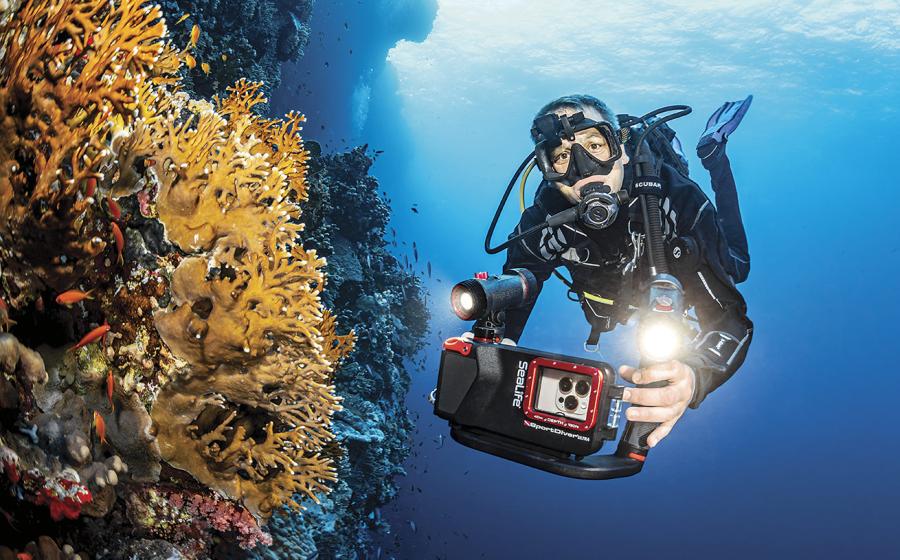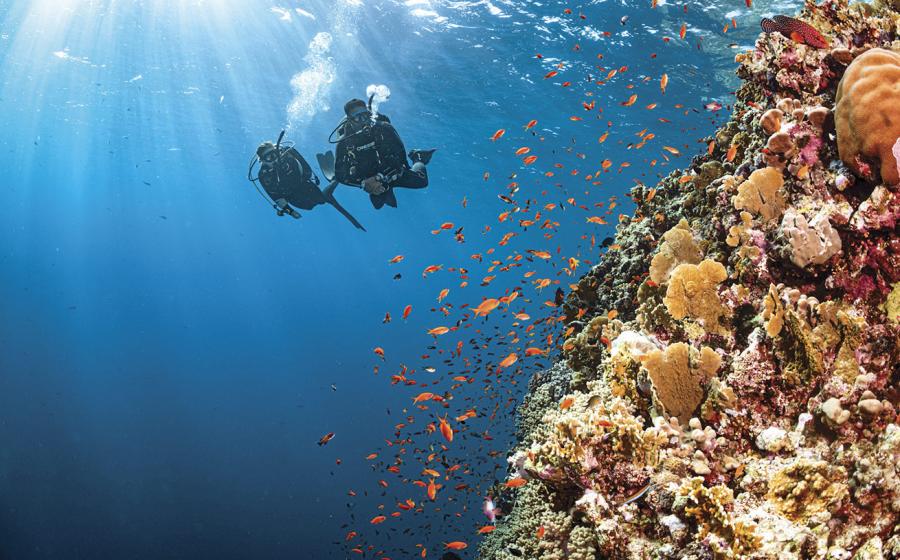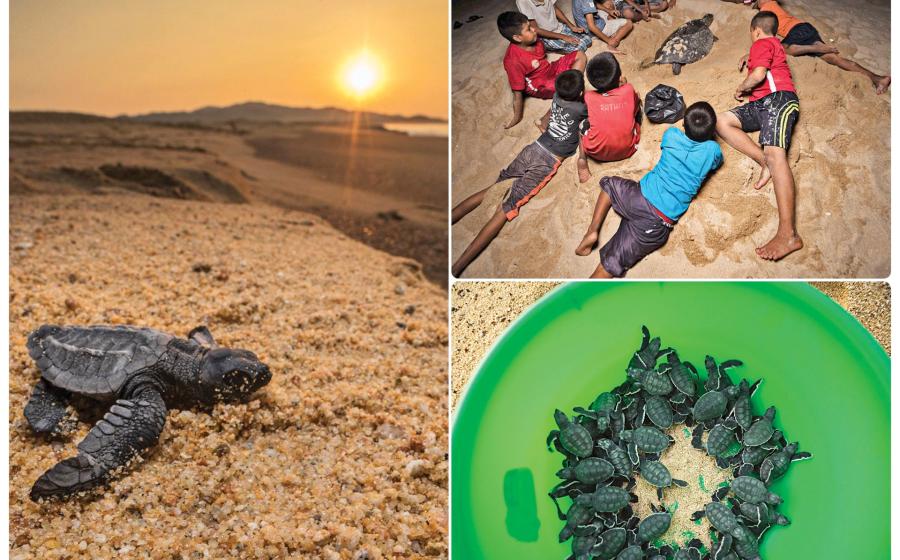Arctic Colossus
The Arctic Ocean was as calm as a garden pond. Except for our boat wake, not a ripple could be seen across the endless expanse. A perfectly symmetrical mirror image of billowing white clouds reflected off the flat ocean, tricking the eye into believing there was no horizon. The white light of the Arctic sun illuminated the water and snow with a brilliance sure to impress even those accustomed to the world's most scorching deserts. But this was a desert of a different kind - a frigid desert of water and ice yet, very much alive. Jellyfish by the thousands floated silently past, seals fished the waters for Arctic char and giant bowhead whales searched for krill. Meanwhile, the colossal walruses basked in the dazzling sunshine, digesting clams that they had retrieved from the sea floor. ur visit marked the first time that a group of recreational divers had explored the waters of Igloolik, a tiny island off the northwest coast of Canada's Baffin Island. Located more than 180 miles north of the Arctic Circle's outer boundary, this frigid, fertile region has attracted and sustained nomadic hunters for more than 4,000 years. The visit came at a historic time, as Igloolik lies within Nunavut - a new Canadian territory officially created on April 1, 1999. Nunavut, pronounced "Noo-na-voot," means "our land" in Inuktitut, the language of the Inuit. Eighty-five percent of the territory's 24,730 residents are Inuit, the name that has replaced "Eskimo." At Igloolik, we loaded thousands of pounds of gear onto wooden sleds called komatiks. Traditionally made of whalebone and pulled by dog teams, komatiks are lashed together with seal-hide rope rather than nails and, consequently, absorb every bump with ease. Our guides' single concession to modern technology was the use of snowmobiles rather than dogs as a source of propulsion. An hour's ride brought us to base camp - our home for the next two weeks. From camp, which was situated a half-mile from the edge of the ice floe, we frequently traveled an hour or more by boat to find whales and walrus. Since compasses do not work so close to the magnetic North Pole, the guides navigated by the sun. Moving ice masses caused frequent detours. Whenever the winds rose and whipped the seas, we would remain on the ice and explore the waters below. The ecosystem along the floe-edge reflects the amazing diversity of life found in the Arctic. Sea anemones litter the ocean floor, and the ice formations where ridges had collided at different times created a unique underwater cathedral effect. The water depth ranged from as shallow as 10 feet to hundreds of feet. With the exception of a one-day blizzard that gave us a small taste of the real Arctic, weather conditions were favorable most of the time. The summer sun never set and air temperatures ranged from 25 to 45 degrees. Water temperatures hovered around 30 degrees. A TOLERANT HOST Our first walrus encounter took place in an expanse of ice and water known as the Foxe Basin. We motored toward a group of indistinct black islands which, as we drew near, transformed into floating chunks of ice crowded with walruses of all sizes and shapes. Gray steam from their body heat and vaporous exhalations rose through the crisp air. We cut the engines and paddled closer to one of the larger ice islands. The dominant males imperiously guarded their turf at the center of the island (the warmest location) and continued to tusk one another, unmindful of our boats. A few protective mothers and curious young walrus lying on the outer edge warily watched our approach and ultimately decided to abandon the island in a noisy stampede into the safety of open water. Though awkward on land, walrus are extremely fast and capable swimmers. Viewing them in the water requires both stealth and luck. We began by donning drysuits and gear on a large ice floe before piling back into the boat for a slow approach to a solitary walrus perched on a small piece of ice some distance from the herd. Slipping into Arctic water to observe a walrus for the first time is an unforgettable experience. The subfreezing water temperature was the last thing on our minds as we inched toward the floating ice, taking care to move slowly and breathe quietly through our snorkels. We were ready to switch to scuba and drop quickly should the walrus exit into the water. Moving closer, our initial caution was replaced by amazement at the animal's sheer size. Using eye contact and the occasional snort, the lackadaisical walrus let us know that he was keenly aware of our presence. At close range, we could gauge the size of his tusks and observe the scars and open wounds on his enormous fins - the result of recent turf wars. After a few minutes in the water, Paul Macintosh decided to swim to the other side of the ice, strip off his gear and inch toward the walrus topside. I stayed behind the walrus to provide an additional subject for his photography - and to document his approach. But as Paul crept closer and closer, I became increasingly uncomfortable with the realization that I was positioned directly in the walrus' escape path. As is sometimes the case, this walrus seemed almost indifferent to our presence. Paul inched forward until he was within reach of the animal's huge tail. We exhausted our film, then retreated to the boat. Although this first encounter seemed tame in retrospect, the experience will forever be etched in my memory just as a diver can vividly recall his or her first shark encounter and all of the apprehension and fear that is so quickly transformed into admiration and awe. SWIM-BY SIGHTINGS During the next two weeks, we interacted with hundreds of walrus on the ice and swam with dozens in the water. Much of the time, we were able to come within a few feet of the resting creatures without disturbing them. Occasionally, however, the walrus would hurl themselves into the water as our boat approached. When this happened, we would slip quietly into the water and wait. More often than not, the walrus would swim away. But sometimes they would simply circle the area, waiting for us to leave. On one occasion, the pack swam to the opposite side of an iceberg and then climbed onto a ledge just below water level. From this vantage point, they could extend their necks down and watch the divers below. But even when a herd abandoned their iceberg, there was still a good chance of an encounter. Our Inuit guides would leave us floating beneath the iceberg and set out in search of the walrus. Hovering in the deep-blue water beneath a large chunk of ice dozens of miles away from shore was, to say the least, a sobering experience. We would wait and listen anxiously for the sound of the returning boat, which usually signaled the appearance of an enormous herd of walrus. Although the visibility was very good - often in excess of 200 feet - the speed with which the animals move made photography difficult. Encounters were generally fleeting but always awe-inspiring. CLOSE CONTACT Underwater encounters with walrus are extremely rare and very little is known about their social behavior underwater. On one occasion, team member Ross Mason was preparing to descend when five walrus surfaced right next to him. The water had been as smooth as glass when suddenly ripples appeared all around him. Walrus heads popped up to inspect this new foreign creature, and Ross found himself surrounded. Another expedition member was Adam Ravage, a National Geographic cinematographer who has spent years in Igloolik and is considered to be a top walrus expert. Adam and I made a particularly exciting dive in an area of dense pack ice. Floating back to back, alert for any sign of movement, we could hear the faint motor noises of the guide boats moving through the confused ice flow. Suddenly, like a school of giant fish, a pack of walrus cruised by. The agility and ease with which they moved underwater was in stark contrast to their laborious movements on land or ice. One walrus, a bull some 12 feet long and weighing perhaps 1,500 pounds, took particular interest in us. As he broke from the pack and swam toward me, I dropped slowly from 30 to 60 feet. The walrus followed, hesitated and then turned and rejoined his group. On another occasion, photographer Amos Nachoum attracted the attention of a curious pup. The moment changed from playful to serious, however, when the mother appeared and, with the speed of a torpedo, delivered a bone-jarring head butt. The mother charged two more times, but Amos was lucky to come away with nothing more than a bruise on his hip and a slight tear in his drysuit. Needless to say, we all took a much more conservative approach after that incident. SEALS AND WHALES Like the walrus, bearded seals live on the floating pack ice, but they are more skittish and difficult to observe. Paddling quietly brought us close enough for photography with a telephoto lens, but the seals proved far less tolerant of human presence than the walrus. Over the course of the trip, we experimented with several methods of approaching the basking seals - including the use of Farrallon DPVs to sneak up from afar. Despite our limited success, the process will likely be refined on subsequent trips. When the ice was 4 to 6 feet thick, the easiest way to enter the water was to widen an existing seal hole. Although we hoped for an underwater encounter with the seals, we were often thwarted by their ability to spy on us from another hole a few hundred yards away. On our final day in Igloolik, we had the good fortune of finding bowhead whales. The bowheads, which swim under the ice to protect themselves from pods of predatory killer whales, seemed to be in a playful mood on this occasion. Two or even three whales would swim side by side, slapping their tails repeatedly. The overwhelming beauty of the tranquil ocean illuminated by the midnight sun, with whales in the foreground and large icebergs on the horizon, was a truly spiritual experience that will stay with me forever. The Arctic is an amazing place that one must personally experience to fully comprehend its wild beauty and solitude. Although every diver on the trip was an experienced traveler, the expedition was a unique experience for all of us. Indeed, the Arctic draws those that have been fortunate enough to experience it. Though far removed from the comforts of modern society, most visitors return many times. Do the encounters described in this story amount to exciting adventure or harassment of wildlife? Tell us what you think. Send your response to Sport Diver, PO Box 2456, Winter Park, Fl 32790. Or send an e-mail to: [email protected].






